báo cáo hóa học: " Ships, ports and particulate air pollution - an analysis of recent studies" potx
Bạn đang xem bản rút gọn của tài liệu. Xem và tải ngay bản đầy đủ của tài liệu tại đây (793.98 KB, 6 trang )
REVIEW Open Access
Ships, ports and particulate air pollution - an
analysis of recent studies
Daniel Mueller
*
, Stefanie Uibel, Masaya Takemura, Doris Klingelhoefer and David A Groneberg
Abstract
The duration of use is usually significantly longer for m arine vessels than for roadside vehicles. Therefore, these
vessels are often powered by relatively old engines which may propagate air pollution. Also, the quality of fuel
used for marine vessels is usually not comparable to the quality of fuels used in the auto motive sector and
therefore, port areas may exhibit a high degree of air pollution. In contrast to the multitude of studies that
addressed outdoor air pollution due to road traffic, only little is known about ship-related air pollution. Therefore
the present article aims to summarize recent studies that address air pollution, i.e. particulate matter exposure, due
to marine vessels. It can be stated that the data in this area of research is still largely limited. Especially, knowledge
on the different air pollutions in different sea areas is nee ded.
Introduction
Air quality issues are extremely important for both
occupational and environmenta l health. In this respect,
numerous airborne factors negatively influenc e human
health [1-6]. In port cities and coastal areas many
sources of air pollution can be found. These air pollu-
tion sources are ship traffic, industry, rail traffic, and
usual sources such as residential emissions (Figure 1).
Whereas numerous studies on road traf fic-related air
pollution have been conducted in the past, only little is
known about the m agnitude and effects of air pollutio n
due to marine vessels. According to the U.S. environ-
mental protection agency (EPA) particulate matter (PM)
is one of the six common air pollutants [7]. PM can be
categorized to the main fractions such as PM10, PM2.5
and ultrafine particles (UFP). PM10 and PM2.5 are
defined as particulate matter with a diameter of 10
micrometers (μm) respectively 2.5 μm collected with
50% efficiency by a sampling collection device [8]. UFP
are particles with a diameter less than or equal to a
nominal 0.1 μm. These small particles can depose deep
in the respiratory tract, and there are multiple proven
associations between these particles and acute or
chronic health effects [9-20]. Therefore, this review
focuses on air pollution by PM emission, especially
PM10 and PM2.5 emissions, due to shipping and port
activities.
Measurements of PM concentration in coastal
regions
In a multi-year study conducted from 2003 to 2007 by
Pandolfi et al., ambient PM10 and PM2.5 data were col-
lected at four sampling locations around the Bay of
AlgecirasinsouthernSpain.ToidentifymajorPM
sources - with particular attention paid to the q uantifi-
cation of total shipping emissions - positive matrix fac-
tori zation m odels were used [21]. After that, the impact
of the emissions from the harbor of Algeciras and vessel
traffic at the Western entra nce of Me diterranean Sea
were quantified. For the estim ation of shipping depen-
dent PM emissions, ambient levels of vanadium (V),
nickel (Ni), lanthanum (La) and c erium (Ce) were used
as markers in this study [21]. According to the scien-
tists, the shipping emissions were characterized by La/
Ce ratios between 0.6 and 0.8 and V/Ni ratios around 3
for both PM10 and PM2.5. It was estimated that the
direct contribution from shipping in the Bay of Alge-
ciras PM10 was 1.4 to 2.6 μg/m
3
(3-7%) and PM2.5 con-
centration was 1.2 to 2.3 μg/m
3
(5-10%). The study
demonstrated further, that t he total contribution from
shipping reached 4.7 μg/m
3
(13%) for PM10 and 4.1 μg/
m
3
(17%) for PM2.5 [21].
In another study Agrawal et al. investigated the impact
of primary fine particulate matter PM2.5 from ship
* Correspondence:
Department of Toxicology, Institute of Occupational Medicine, Social
Medicine and Environmental Medicine, Goethe-University, Frankfurt,
Germany
Mueller et al. Journal of Occupational Medicine and Toxicology 2011, 6:31
/>© 2011 Mueller et al; licensee BioMed Central Ltd. This is an Open Access article distributed under the terms of the Creative Commons
Attribution Lic ense ( which permits unrestricted use, distribution, and reproduction in
any medium , provided the original work is properly cited.
emissions w ithin the Southern California Air Basin. In
thisstudyalsoVandNiwereusedasmarkerforthe
shipping emissions [22]. V and Ni were measured in
stack emissions of in-use ocean-going vessels (OGVs)
and then compared with ambient measurements made
at 10 monitoring stations throu ghout Southern Califor-
nia. The researcher could demonstrate that the transi-
tion metals V and Ni are robust markers for the
combustion of heavy fuel o il in OGVs [22]. In this
respect, it was found that ambient measurements of fine
particulate V and N i within Southern California are
shown to decrease inversely with increased distance
from the ports of Los Angeles and Long Beach. To esti-
mate the primary PM2.5 contributions from OGVs at
the multiple monitoring locations the researcher used
normalized emission rates. In relation to the total
PM2.5 Agrawal et al. found that primary PM2.5 contri-
butions f rom OGVs range from 8.8% at the monitoring
location closest to the port to 1.4% monitored 80 km
inland [22]. The scientists concluded that the results of
their analysis will be u seful i n determining the impacts
of primary particulate emissions from OGVs upon
worldwide communities downwind of port operations.
In the same region of Southern California, Ault et al.
studied the impact of emissions during regional shipping
transport events [23]. Atmospheric aerosol measure-
ments during time periods with regional transport
showed an in crease in 0.5 -1 μm sized single particles
with unique signatures including soot, metals (i.e., vana-
dium, iron, and nickel), sulfate, and nitrate in La Jolla,
California [23]. Ault et al. assumed as well that t hese
particles can be attributed to primary emissions from
residual oil sources such as ship engine exhaust. How-
ever, the authors of this study state that these particles
could also be attributed to emissions of refineries and
traffic in the port region as well as to secondary proces-
sing during the transport. The results of these measure-
ments showed 2-4 times higher PM2.5 c oncentrations
than typical average concentrations from local s ources
[23]. Ault et al. therefore conclude that unless signifi-
cant regulations are imposed these emission sources will
become even more important to California air quality as
cars and truck emissions. Elevation of PM2.5 concentra-
tion in coastal regions due to ship engine emissions was
as well reported by a Canadian s tudy carried out by
Poplawski et al. They investigated the association
between community level concentrations of PM 2.5 with
cruise ships traffic in Victoria, British Columbia [24].
They obtained data from 2005 to 2008 at a close air
quality network site (3.5 km from the study area) and
took continuous measurements in the James Bay com-
munity over a three-month period during the 2009
cruise ship season. Next to PM2.5 they also investigated
concentrations of some gaseous air pollutants. The mea-
surements downwind the port showed an elevation of
PM2.5 concentration on weekends when cruise ship
activity reached the weekly maximum [24].
In Turkey, Deniz et al. investigated in 2010 within two
adjacent studies the shipping emissions in coastal
regions w ith heavy shipping traffic. The first study was
carried out in the Candarli Gulf and the second study at
the Ambarli Port [25,26]. The objective of the studies
was to estimate the amount of major atmo spheric com-
ponents emitted from heavy ship engines. Next to some
gaseous air pollutants the studies focused mainly on PM
with no distinction between different PM-fractions. The
first study in the Candarli Gulf PM investigated the
annual shipping emissions from 7520 ships during the
year of 2007 and the researcher estimated 57.4 tons per
year (t/y) for PM [26]. In the second study Deniz et a l.
calculated the exhaust emissions from ships at the
Ambarli Port by utilizing data acquired in 2005. The
total emission from ships at this port was estimated
with 36 t/y for PM by the scientists [25].
Healy et al. characterized in a 2009 study single parti-
cles from in-port ship emissions in the Port of Cork in
Ireland [27]. In this study, the size and composition of
freshly emitted individual ship exhaust particles was
investigated. For the measurement an aerosol time-of-
flight mass spectrometer was used (ATOFMS) co-
located with a suite of real-time instrumentations at a
site in the Port of Cork. Clustering the collected spectra
by using the K-means algorithm, they could identify a
unique ship exhaust class containing internally mixed
elemental and organic carbon, sodium, calcium, iron,
Figure 1 Factors that can influence air quality in port cities
and coastal areas.
Mueller et al. Journal of Occupational Medicine and Toxicology 2011, 6:31
/>Page 2 of 6
vanadium, nickel and sulfate [27]. During the three week
measurement period in August 2008 the Healy et al.
group could observe over twenty sharp emission events
for this particle type. Coinci dent increases in mass con-
centrations of sulfate, elemental carbon and PM2.5 were
also observed during these events in this study. Further-
more, simultaneous scanning mobility particle sizer
(SMPS) measurements were used. The results o f this
SMPS monitoring showed that the vast majority of
freshly emitted ship exhaust particles is present in the
ultrafine mode (< 100 nm diameter) [27]. A second par-
ticle class constituted of internally mixed organic car-
bon, elemental carbon, ammonium and sulfate. The
scientists tentatively attributed this s econd particle class
to aged or regionally transported ship exhaust. On basis
of these findings, Healy et al. suggested that ATOFMS
single particle mass spectra may be useful in determin-
ing the contribution of local shipping traffic to air qual-
ity in p ort cities, when used in conjunction with other
air quality monitoring instrumentation [27].
Effect of ship type and fuel type on the PM
concentration in ship emissions
In a recent article Johnson et al. investigated size-
resolved emission factors for particle number (EF (PN))
and mass (EF (PM)) for 734 individual ship passages.
This study was carried out in Sweden near the entrance
to the po rt of Gothenburg [28]. In th eir experiments an
extractive sampling method of the passing ship plumes
was used and next to gaseous emissions (CO
2
) the parti-
cle number/mass were measured wit h high time resolu-
tion (1 Hz). The place of measurement was situated in
an emission control area (ECA) and near to populated
areas. The investigation resulted in an average EF (PN)
andEF(PM)of2.55+/-0.11×10
16
(kg fuel)
-1
and
2050 +/- 110 mg (kg fuel)
-1
, respectively [28]. For ships
with multiple passages, a great reproducibility for the
determined EF was s hown and the EF(PN) peaked at
particle si zes similar to 35 nm [28]. Interestingly, com-
pared to ships with diesel engines, ships equipped with
gas turbine showed smaller particle sizes and less mass.
On average 36 to 46% of the emitted particles by num-
ber were non-volatile [28].
In a 2011, a real-time study by Jayaram et al. assessed
gaseous emissions and PM2.5 emissions of a ship engine
powered with different fuel types [29]. The authors mea-
sured regulated and unregulated emissions from an in-
use marine propulsion engine (EPA Tier 2) on a ferry in
a real-time fashion. For comparison with the certifica-
tion standards and across b iodiesel blends the investi-
gated engine was operated following the loads in ISO
8178-4 E3 cycle. Furthermore, real-time measurements
were made during a typical cruise in the bay. As a result
Jayarametal.wereabletodemonstratethatin-use
PM2.5 emission factors were within t he not-to-exceed
standard for Tier 2 marin e engines. The comparison of
the fuels showed for PM2.5 a reduction of 16% on ships
fuelled w ith Biodiesel B20 and of 25% on ships fuelled
with Biodiese l B50 [29] . Furthermore, reduct ions in t he
volume mean diameter and total number concentration
in the accumulation mode with increasing biodiesel
blends was observed. These findings were consistent
with trends found in gravimetric PM2.5 mass emissions
[29]. In other studies similar trends of particle size and
number reduction in accumulat ion mode with biodiesel
was reported [30,31]. Jayaram et al. were able to demon-
strate the i mportant effects of ocean/bay currents on
emissions. Due to this effect, PM2.5 mass increased
about 6-fold and ultrafine particles (UFP) disappeared
[29]. Based on the findings, the authors conclude that
for the development of emission inventories the effect of
ocean currents should be considered. In this respect, in-
use measurements may provide necessary data for accu-
rate inventories [29].
In regard to an approaching fuel switch within the
marine sector, a study was conducted by Winnes et al.
with the aim to investigate the effects of different fuel
types on ship exhaust gas composition and emission fac-
tors with a focus on particles [32]. The field emission
measurements were carried out on the 4500-kW four-
stroke main engine on-board a product tanker. In the
study, heavy fuel oil and marine gas oil were tested on
the same engine for comparable load settings [32]. In
this study PM with no distinction of different fraction
was measured. The authors reported for heavy fuel oil
generally higher specific PM emissions than for marine
gas oil but for the smallest size-fraction containing par-
ticles 0.30- 0. 40 μm in diameter, the opposite was
observed [32]. The authors’ conclusion of these findings
is that further regulation is needed to reduce small-sized
particles and hence negative health effects of particles
from ships.
Characterization of the PM composition in ship
emissions
Only few published studies focused on the characteri za-
tion of the PM composition in ship emissions. One pro-
ject was an international study carried out by
Moldanova et al. (2009) that investigated PM in emis-
sions f rom a large ship diesel engine [33]. The engine
was fueled with heavy fuel oil (HFO). The investigation
of th e emitted PM included mass, size distribution, che-
mical composition and microphysical structure of the
PM. The study assessed a n emission factor for PM of
5.3 g (kg fuel)
-1
. Further, the mass size distribution
showed increased particles of the accumulation mode
(mean diameter of 0.5 μm) and the coarse mode
(around 7 μm) [33]. The investigation demonstrated a
Mueller et al. Journal of Occupational Medicine and Toxicology 2011, 6:31
/>Page 3 of 6
domination of organic carbon (OC), ash and sulfate in
the PM composition whereas elemental carbon (EC)
composed only a few per cent. It is to point out that
increase of PM in t he exhaust u pon cooling, was asso-
ciated with increase of OC and sulfate. Interestingly,
cooling o f the exhaust as well showed an effect on the
quantity of polycyclic aromatic hydrocarbons (PAHs)
absorbed on the surface of particulates. Whereas the
analysis of the adsorbed phase in the cooled exhaust
presented a rich mixture of PAH species wit h molecular
mass between 178 and 300 atomic mass units (amu) the
hot exhaust showed only 4 a mu of PAH [33] . In t he
performed microstructure and elemental analysis of ship
combustion residuals three following distinct morpholo-
gical structures with different chemical composition
were found: soot aggregates, significantly meta l polluted;
char particles, clean or containing minerals; mineral
and/or ash particles [33]. In addition, the researcher
coul d observe organic carbon particles of unburned fuel
or/and lubricating oil origin were. It should be pointed
out that haza rdous constituents from the combustion of
heavy fuel oil (V, N i, Ca, and Fe (iron)) were observed
in the PM samples as well. T hese metals were also used
in other studies as marker for ship emissions as
described above.
In a 2009 study carried out by Murphy et al. the parti-
culate exhaust from a modern container ship burning
heavy fuel oil was characterized [34]. The ship emissions
were measured shipboard and airborne with a focus o n
the chemical composition and water-uptake behavior of
particulate matter in the exhaust. The following results
were obtained: The mass ratio of particulate organic car-
bon to sulfate was 0.23 +/- 0.03 at the base of the ship
stack and 0.30 +/- 0.01 in the airborne exhaust plume
[34]. The addit ional organic mass in the airb orne plume
was concentrated largely in particles below 100 nm in
diameter [34]. The organic to sulfate mass ratio in t he
exhaust aerosol remained constant during the first hour
of plume dilution into the marine boundary layer [34].
The authors also reported that the mass spectrum o f
the organic fraction of the exhaust aerosol appeared to
be predominantly hydrocarbon-like organic (HOA)
material [34]. The background aerosol contained a
lower organic mass fraction than the fresh plume with
much more oxidized organic component [34]. With a
conducted analysis of the water-uptake behavior of par-
ticulate in the exhaust the researcher showed that a
volume-weighted mixing r ule is able to accurately pre-
dict hygroscopic growth factors in the background aero-
sol. However, measured and calculated growth factors
do not agree for aerosols in the ship exhaust plume.
The researchers estimated the particle number emission
factor a t 1.3 × 10
16
(kg f uel)
-1
,withlessthan1/10of
the particles having diameters above 100 nm and 24% of
particles (> 10 nm in diameter) activate into cloud dro-
plets at 0.3% supersaturation [34].
A third study that aimed to characterize the PM com-
position in ship emissions focused on the urban area of
Venice in Italy. Contini et al. estimated in this study the
direct influence of ship traffic on atmosph eric PM2.5
and PM10. Next to PM, the study also estimated fifteen
PAHs. The sample collection was performed over the
summer when ship traffic i s expected to be at a maxi-
mum and on three sites in that area [35]. From the
received r esults the researcher concluded that the PM
daily concentrations are not sufficiently detailed for the
evaluation. There fore they developed a new methodol-
ogy, based on high temporal resolution measurements
coupled with wind direction information and the data-
base of ship passages of the Harbor Authority of Venice
[35]. PM10 and PM2.5 were monitored with optical
detectors operating at a high temporal resolution [35].
With this new setup, the study showed that direct con-
tribution of ships traffic to PM
2.5
and to PM
10
ranges
from 1% up to 8% [35].
Conclusion
This review of the recent published literature shows that
port and populated coastal areas with heavy ship traffic
are affected by exhausts of particulates from marine ves-
sels. From the different studies it can be concluded that
further international regulations are necessary to assess
vessel-related air pollution due to ship traffic emissions.
In this respect, recent articles have shown that simple
fuel change of marine vessel engines alone may not suf-
ficiently reduce effects caused by ship emissions. The
few publications that analyzed the composition of PM in
ship emissions show the importance of this kind of
Figure 2 Characterized compounds of e missions from marine
vessel engines as reported in the reviewed articles.
Mueller et al. Journal of Occupational Medicine and Toxicology 2011, 6:31
/>Page 4 of 6
approach. Knowledge about the nature of the com-
pounds of ship emissions helps t o discriminate these
pollutant sources from others in the port areas and
coastal regions (Figure 1). Promising markers for ship
engine exhaust a re specific metals like vanadium and
nickel although there are is a large variety and quantity
of other harmful substances present (Figure 2). Since
there is still only little published data regarding the
quality and quantity of particles emitted from ship
engines, modern scientometric tools which are in use
for the analysis of other research areas are not applic-
able in this area [36-44].
Acknowledgements
We thank G. Volante for expert help. Publication of this review was partly
supported by EUGT e. V.
Authors’ contributions
DM, SU, MT, DK, DAG have made substantial contributions to the
conception and design of the review, acquisition of the review data and
have been involved in drafting and revising the manuscript. All authors have
read and approved the final manuscript.
Competing interests
The authors declare that they have no competing interests.
Received: 24 August 2011 Accepted: 5 December 2011
Published: 5 December 2011
References
1. Elfman L, Riihimaki M, Pringle J, Walinder R: Influence of horse stable
environment on human airways. J Occup Med Toxicol 2009, 4:10.
2. Groneberg DA, Fischer A: Occupational medicine and toxicology. J Occup
Med Toxicol 2006, 1:1.
3. Groneberg DA, Nowak D, Wussow A, Fischer A: Chronic cough due to
occupational factors. J Occup Med Toxicol 2006, 1:3.
4. Groneberg DA, Scutaru C, Lauks M, Takemura M, Fischer TC, Kolzow S, van
Mark A, Uibel S, Wagner U, Vitzthum K, et al: Mobile Air Quality Studies
(MAQS)-an international project. J Occup Med Toxicol 2010, 5:8.
5. Groneberg-Kloft B, Kraus T, Mark A, Wagner U, Fischer A: Analysing the
causes of chronic cough: relation to diesel exhaust, ozone, nitrogen
oxides, sulphur oxides and other environmental factors. J Occup Med
Toxicol 2006, 1:6.
6. Sierra-Vargas MP, Guzman-Grenfell AM, Blanco-Jimenez S, Sepulveda-
Sanchez JD, Bernabe-Cabanillas RM, Cardenas-Gonzalez B, Ceballos G,
Hicks JJ: Airborne particulate matter PM2.5 from Mexico City affects the
generation of reactive oxygen species by blood neutrophils from
asthmatics: an in vitro approach. J Occup Med Toxicol 2009, 4:17.
7. Six Common Air Pollutants. [ />8. Europäische Union: Richtlinie 2008/50/EG des Europäischen Parlaments
und des Rates - über Luftqualität und saubere Luft für Europa. Book
Richtlinie 2008/50/EG des Europäischen Parlaments und des Rates - über
Luftqualität und saubere Luft für Europa 2008, 9-31, (Editor ed.^eds.). pp. 9-
31. City.
9. Atkinson RW, Anderson HR, Sunyer J, Ayres J, Baccini M, Vonk JM,
Boumghar A, Forastiere F, Forsberg B, Touloumi G, et al: Acute effects of
particulate air pollution on respiratory admissions - Results from APHEA
2 project. Am J Respir Crit Care Med 2001, 164:1860-1866.
10. Brook RD, Rajagopalan S, Pope CA, Brook JR, Bhatnagar A, Diez-Roux AV,
Holguin F, Hong YL, Luepker RV, Mittleman MA, et al: Particulate Matter Air
Pollution and Cardiovascular Disease An Update to the Scientific
Statement From the American Heart Association. Circulation 2010,
121:2331-2378.
11. Dominici F, Peng RD, Bell ML, Pham L, McDermott A, Zeger SL, Samet JM:
Fine particulate air pollution and hospital admission for cardiovascular
and respiratory diseases. Jama-Journal of the American Medical Association
2006, 295:1127-1134.
12. Gavett SH, Koren HS: The role of particulate matter in exacerbation of
atopic asthma. Int Arch Allergy Immunol 2001, 124:109-112.
13. Gehring U, Heinrich J, Kramer U, Grote V, Hochadel M, Sugiri D, Kraft M,
Rauchfuss K, Eberwein HG, Wichmann HE: Long-term exposure to ambient
air pollution and cardiopulmonary mortality in women. Epidemiology
2006, 17
:545-551.
14.
Ko FWS, Hui DSC: Outdoor air pollution: impact on chronic obstructive
pulmonary disease patients. Curr Opin Pulm Med 2009, 15:150-157.
15. Pope CA, Kanner RE: Acute effects of pm-10 pollution on pulmonary-
function of smokers with mild-to-moderate chronic obstructive
pulmonary-disease. Am Rev Respir Dis 1993, 147:1336-1340.
16. Sint T, Donohue JF, Ghio AJ: Ambient air pollution particles and the
acute exacerbation of chronic obstructive pulmonary disease. Inhal
Toxicol 2008, 20:25-29.
17. Sunyer J, Basagana X: Particles, and not gases, are associated with the
risk of death in patients with chronic obstructive pulmonary disease. Int
J Epidemiol 2001, 30:1138-1140.
18. Tecer LH, Alagha O, Karaca F, Tuncel G, Eldes N: Particulate matter (PM2.5,
PM10-2.5, and PM10) and children’s hospital admissions for asthma and
respiratory diseases: A bidirectional case-crossover study. Journal of
Toxicology and Environmental Health-Part a-Current Issues 2008, 71:512-520.
19. Vidale S, Bonanomi A, Guidotti M, Arnaboldi M, Sterzi R: Air pollution
positively correlates with daily stroke admission and in hospital
mortality: a study in the urban area of Como, Italy. Neurol Sci 2010,
31:179-182.
20. Yeatts K, Svendsen E, Creason J, Alexis N, Herbst M, Scott J, Kupper L,
Williams R, Neas L, Cascio W, et al: Coarse particulate matter (PM2.5-10)
affects heart rate variability, blood lipids, and circulating eosinophils in
adults with asthma. Environ Health Perspect 2007, 115:709-714.
21. Pandolfi M, Gonzalez-Castanedo Y, Alastuey A, de la Rosa JD, Mantilla E, de
la Campa AS, Querol X, Pey J, Amato F, Moreno T: Source apportionment
of PM(10) and PM(2.5) at multiple sites in the strait of Gibraltar by PMF:
impact of shipping emissions. Environ Sci Pollut Res 2011, 18:260-269.
22. Agrawal H, Eden R, Zhang X, Fine PM, Katzenstein A, Miller JW, Ospital J,
Teffera S, Cocker DR III: Primary Particulate Matter from Ocean-Going
Engines in the Southern California Air Basin. Environ Sci Technol 2009,
43:5398-5402.
23. Ault AP, Moore MJ, Furutani H, Prather KA: Impact of Emissions from the
Los Angeles Port Region on San Diego Air Quality during Regional
Transport Events. Environ Sci Technol 2009, 43:3500-3506.
24. Poplawski K, Setton E, McEwen B, Hrebenyk D, Graham M, Keller P: Impact
of cruise ship emissions in Victoria, BC, Canada. Atmos Environ 2011,
45:824-833.
25. Deniz C, Kilic A: Estimation and Assessment of Shipping Emissions in the
Region of Ambarli Port, Turkey. Environ Prog Sustain Energy 2010,
29:107-115.
26. Deniz C, Kilic A, Civkaroglu G: Estimation of shipping emissions in
Candarli Gulf, Turkey. Environ
Monit Assess 2010, 171:219-228.
27. Healy RM, O’Connor IP, Hellebust S, Allanic A, Sodeau JR, Wenger JC:
Characterisation of single particles from in-port ship emissions. Atmos
Environ 2009, 43:6408-6414.
28. Jonsson AM, Westerlund J, Hallquist M: Size-resolved particle emission
factors for individual ships. Geophys Res Lett 2011, 38.
29. Jayaram V, Agrawal H, Welch WA, Miller JW, Cocker DR: Real-Time Gaseous,
PM and Ultrafine Particle Emissions from a Modern Marine Engine
Operating on Biodiesel. Environ Sci Technol 2011, 45:2286-2292.
30. Heikkila J, Virtanen A, Ronkko T, Keskinen J, Aakko-Saksa P, Murtonen T:
Nanoparticle Emissions from a Heavy-Duty Engine Running on
Alternative Diesel Fuels. Environ Sci Technol 2009, 43:9501-9506.
31. Jung H, Kittelson DB, Zachariah MR: Characteristics of SME biodiesel-
fueled diesel particle emissions and the kinetics of oxidation. Environ Sci
Technol 2006, 40:4949-4955.
32. Winnes H, Fridell E: Particle Emissions from Ships: Dependence on Fuel
Type. J Air Waste Manage Assoc 2009, 59:1391-1398.
33. Moldanova J, Fridell E, Popovicheva O, Demirdjian B, Tishkova V,
Faccinetto A, Focsa C: Characterisation of particulate matter and gaseous
emissions from a large ship diesel engine. Atmos Environ 2009,
43:2632-2641.
Mueller et al. Journal of Occupational Medicine and Toxicology 2011, 6:31
/>Page 5 of 6
34. Murphy SM, Agrawal H, Sorooshian A, Padro LT, Gates H, Hersey S,
Welch WA, Jung H, Miller JW, Cocker DR, et al: Comprehensive
Simultaneous Shipboard and Airborne Characterization of Exhaust from
a Modern Container Ship at Sea. Environ Sci Technol 2009, 43:4626-4640.
35. Contini D, Gambaro A, Belosi F, De Pieri S, Cairns WRL, Donateo A,
Zanotto E, Citron M: The direct influence of ship traffic on atmospheric
PM(2.5), PM(10) and PAH in Venice. Journal of Environmental Management
2011, 92:2119-2129.
36. Groneberg-Kloft B, Fischer TC, Quarcoo D, Scutaru C: New quality and
quantity indices in science (NewQIS): the study protocol of an
international project. J Occup Med Toxicol 2009, 4:16.
37. Vitzthum K, Scutaru C, Musial-Bright L, Quarcoo D, Welte T, Spallek M,
Groneberg-Kloft B: Scientometric analysis and combined density-
equalizing mapping of environmental tobacco smoke (ETS) research.
PLoS One 2010, 5:e11254.
38. Groneberg-Kloft B, Kreiter C, Welte T, Fischer A, Quarcoo D, Scutaru C:
Interfield dysbalances in research input and output benchmarking:
visualisation by density equalizing procedures. International journal of
health geographics 2008, 7:48.
39. Scutaru C, Quarcoo D, Takemura M, Welte T, Fischer TC, Groneberg-Kloft B:
Density-equalizing mapping and scientometric benchmarking in
Industrial Health. Ind Health 2010, 48:197-203.
40. Groneberg-Kloft B, Quarcoo D, Scutaru C: Quality and quantity indices in
science: use of visualization tools. EMBO Rep 2009, 10:800-803.
41. Scutaru C, Quarcoo D, Sakr M, Shami A, Al-Mutawakel K, Vitzthum K,
Fischer TC, Zuberbier T, Groneberg-Kloft B: Density-equalizing mapping
and scientometric benchmarking of European allergy research. J Occup
Med Toxicol 2010, 5:2.
42. Groneberg-Kloft B, Scutaru C, Dinh QT, Welte T, Chung KF, Fischer A,
Quarcoo D: Inter-disease comparison of research quantity and quality:
bronchial asthma and chronic obstructive pulmonary disease. J Asthma
2009, 46:147-152.
43. Kusma B, Scutaru C, Quarcoo D, Welte T, Fischer TC, Groneberg-Kloft B:
Tobacco control: visualisation of research activity using density-
equalizing mapping and scientometric benchmarking procedures. Int J
Environ Res Public Health 2009, 6:1856-1869.
44. Groneberg-Kloft B, Scutaru C, Fischer A, Welte T, Kreiter C, Quarcoo D:
Analysis of research output parameters: density equalizing mapping and
citation trend analysis. BMC Health Serv Res 2009, 9:16.
doi:10.1186/1745-6673-6-31
Cite this article as: Mueller et al.: Ships, ports and particulate air
pollution - an analysis of recent studies. Journal of Occupational Medicine
and Toxicology 2011 6:31.
Submit your next manuscript to BioMed Central
and take full advantage of:
• Convenient online submission
• Thorough peer review
• No space constraints or color figure charges
• Immediate publication on acceptance
• Inclusion in PubMed, CAS, Scopus and Google Scholar
• Research which is freely available for redistribution
Submit your manuscript at
www.biomedcentral.com/submit
Mueller et al. Journal of Occupational Medicine and Toxicology 2011, 6:31
/>Page 6 of 6









